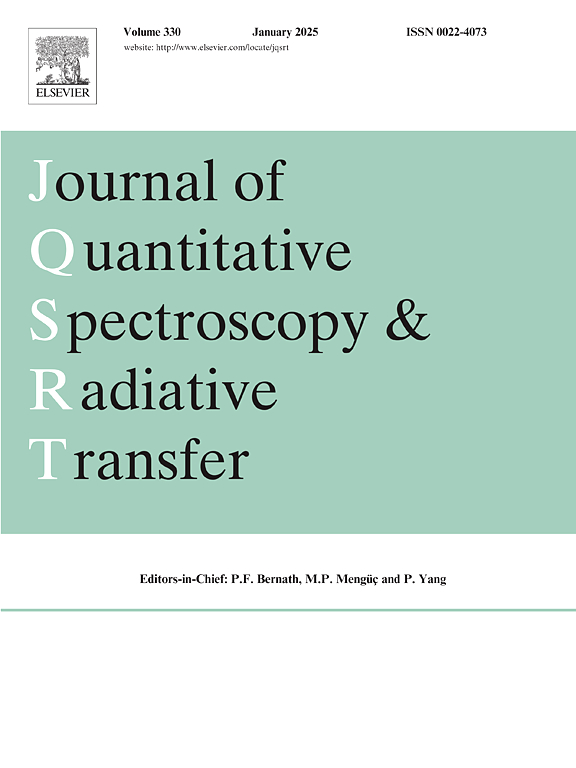Precision frequency comb spectroscopy of the 14N2O, 14N15NO, 15N14NO, and 15N2O isotopocules in the 3300 – 3550 cm–1 range
IF 2.3
3区 物理与天体物理
Q2 OPTICS
Journal of Quantitative Spectroscopy & Radiative Transfer
Pub Date : 2025-03-26
DOI:10.1016/j.jqsrt.2025.109452
引用次数: 0
Abstract
Nitrous oxide is a long-lived greenhouse gas. Its isotopic composition provides valuable insights into sources and sinks, and about the mechanisms of formation. A major challenge in the spectroscopic analysis of the isotopocule compositions is the availability of accurate spectroscopic parameters, particularly for the minor 15N isotopocules. In this work, we introduce high-resolution spectroscopic measurements of four isotopocules of nitrous oxide: 14N2O, 14N15NO, 15N14NO, and 15N2O in the mid-infrared range of 3300 – 3550 cm–1 using a frequency comb-based Fourier transform spectrometer. The nitrous oxide samples were obtained from a chemical synthesis involving acid-catalyzed amine-borane reduction of equimolar amounts of 15N isotopically enriched sodium nitrite and 14N sodium nitrite. The high-resolution spectra, measured in a temperature-controlled single-pass absorption cell, were used to retrieve line center frequencies and relative intensities for a total of 426 rovibrational transitions of the ν1 + ν3 band of the four isotopocules, and of the one order of magnitude weaker 2ν2 + ν3 and ν1 + ν2 + ν3 – ν2 bands in the same spectral region. We compare the determined line center frequencies and relative intensities with spectroscopic parameters available in high-resolution molecular databases. For 14N2O, 14N15NO and 15N14NO we find good agreement with the HITRAN database. The 15N2O isotopocule is missing in HITRAN, and we find that its line center frequencies in the GEISA database, the Institute of Atmospheric Optics database, as well as the Ames-1 line list deviate severely from the comb measurements.
3300 ~ 3550 cm-1范围内14N2O、14N15NO、15N14NO和15N2O同位素的精密频率梳谱
一氧化二氮是一种寿命很长的温室气体。它的同位素组成为了解其来源和吸收汇以及形成机制提供了宝贵的信息。对同位素组成进行光谱分析的一个主要挑战是获得准确的光谱参数,尤其是次要的 15N 同位素。在这项工作中,我们利用基于梳状频率的傅立叶变换光谱仪,在 3300 - 3550 cm-1 中红外范围内对氧化亚氮的四种同位素:14N2O、14N15NO、15N14NO 和 15N2O 进行了高分辨率光谱测量。氧化亚氮样品是通过酸催化胺硼烷还原等摩尔量的 15N 同位素富集亚硝酸钠和 14N 亚硝酸钠的化学合成方法获得的。在温控单通吸收池中测量的高分辨率光谱被用来检索四个同位素分子的 ν1 + ν3 波段以及同一光谱区域中弱一个数量级的 2ν2 + ν3 和 ν1 + ν2 + ν3 - ν2 波段的共 426 个摇振跃迁的线中心频率和相对强度。我们将确定的线中心频率和相对强度与高分辨率分子数据库中的光谱参数进行了比较。对于 14N2O、14N15NO 和 15N14NO,我们发现它们与 HITRAN 数据库有很好的一致性。15N2O 同位素单元在 HITRAN 数据库中缺失,我们发现其在 GEISA 数据库、大气光学研究所数据库以及 Ames-1 线表中的线中心频率与梳状测量值严重偏离。
本文章由计算机程序翻译,如有差异,请以英文原文为准。
求助全文
约1分钟内获得全文
求助全文
来源期刊
CiteScore
5.30
自引率
21.70%
发文量
273
审稿时长
58 days
期刊介绍:
Papers with the following subject areas are suitable for publication in the Journal of Quantitative Spectroscopy and Radiative Transfer:
- Theoretical and experimental aspects of the spectra of atoms, molecules, ions, and plasmas.
- Spectral lineshape studies including models and computational algorithms.
- Atmospheric spectroscopy.
- Theoretical and experimental aspects of light scattering.
- Application of light scattering in particle characterization and remote sensing.
- Application of light scattering in biological sciences and medicine.
- Radiative transfer in absorbing, emitting, and scattering media.
- Radiative transfer in stochastic media.

 求助内容:
求助内容: 应助结果提醒方式:
应助结果提醒方式:


